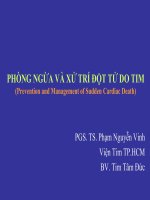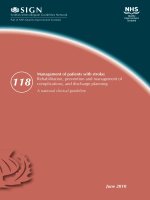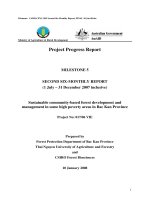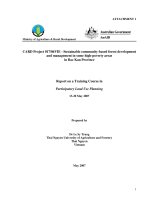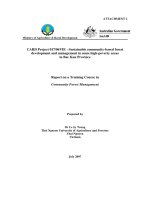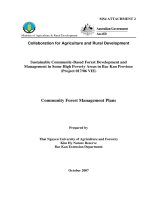Evidence based medicine prevention and management BRONCHOPULMONARY DYSPLASIA
Bạn đang xem bản rút gọn của tài liệu. Xem và tải ngay bản đầy đủ của tài liệu tại đây (120.7 KB, 12 trang )
EVIDENCE BASED MEDICINE
PREVENTION & MANAGEMENT
BRONCHOPULMONARY DYSPLASIA
DIAGNOSTIC CRITERIA FOR BPD
MILD
Supplemental O2
(for 28 days) and
MODERATE
SEVERE
Supplemental
Supplemental O2
O2 (for 28 days) (for 28 days) and
and
<32
RA at 36 weeks
weeks GA corrected GA or at
at birth
discharge
<0.3 FiO2 at 36
weeks corrected
GA or at
Discharge
≥0.3 FiO2 +/–
positive pressure
support at 36
weeks corrected
GA or at discharge
≥32
RA by postnatal
weeks GA day 56
at birth
or at discharge
<0.3 FiO2 by
postnatal day 56
or at discharge
≥0.3 FiO2 +/–
positive pressure
support by
postnatal day
56 or at discharge
PATHOLOGY
EVIDENCE CLASSIFICATION
(THE U.S. PREVENTIVE SERVICES TASK FORCE)
Level I: at least one properly designed randomized
controlled trial.
Level
II-1: well-designed controlled trials without
randomization.
Level II-2: well-designed cohort or case-control analytic
studies, preferably from more than one center or research
group.
Level
II-3: multiple time series +/- without the
intervention. Dramatic results in uncontrolled trials might
also be regarded as this type of evidence.
Level III: Opinions of respected authorities, based on
clinical experience, descriptive studies, or reports of
expert committees
RECOMMENDATION
(THE U.S. PREVENTIVE SERVICES TASK FORCE)
Level A: Good scientific evidence suggests that the
benefits substantially outweigh the potential risks.
Level B: At least fair scientific evidence suggests that the
benefits outweigh the potential risks.
Level C: At least fair scientific evidence suggests that
there are benefits provided, but the balance between
benefits and risks are too close for making general
recommendations.
Level D: At least fair scientific evidence suggests that the
risks outweigh potential benefits.
Level I: Scientific evidence is lacking, of poor quality, or
conflicting, such that the risk versus benefit balance
cannot be assessed
PREVENTION & MANAGEMENT OF BPD
QUESTION?
1.
2.
3.
4.
5.
Oxygen supplementation?
Ventilatory strategy?
Methylxanthines ?
Steroid ?
Fluids, diuretics & nutrition?
EARLY PHASE (UP TO 1 POSTNATAL WEEK)
Therapeutic
intervention
Current status
Level of
evidence
Level of
recommendation
Oxygen
supplementation
SPO2 <95%, usually between 85–93%
I
A
Ventilatory strategy
•Avoid intubation. If intubated, give “early”
surfactant
•Short inspiratory times (0.24–0.4s)
•Rapid rates (40–60/min), low PIP (14–20
cmH2O), moderate PEEP (4–6 cmH2O),low
tidal volume (3–6 mL/kg)
•Extubate early to SNIPPV/NCPAP
•Blood gas targets: pH 7.25–7.35, PaO2 40–
60 mmHg
• PaCO2 45–55 mmHg
•High frequency ventilation for “rescue”, if
conventional ventilation fails
I
A
I
III
A
B
I
III
A
B
I
I
C
A
Methylxanthines
successful extubation rate , BPD
I
A
Vitamin A
5000 IU IM 3 times/ week x 4 weeks 1/1415 additional infant survived without BPD
I
A
Fluids
Restrictive fluid intake may BPD
II-2
B
Nutrition
energy intake
I
B
EVOLVING PHASE (>1 POSTNATAL WEEK TO 36 WEEKS PMA)
Therapeutic
intervention
Current status
Level of
evidence
Level of
recommendation
Oxygen
supplementation
Same as in Table 1
I
A
Ventilatory
strategy
•Avoid endotracheal tube ventilation. Maximize noninvasive ventilation (SNIPPV/NCPAP) for respiratory
support
•Blood gas targets: pH 7.25–7.35 PaO2 40–60 mmHg
PaCO2 45–55 mmHg
I
A
III
B
Methylxanthines
Same as in Table 1
I
A
Vitamin A
Same as in Table 1. If using, continue for 4 postnatal
weeks
I
A
Steroids
•Dexamethasone: wean off mechanical ventilation,
used “moderately early” and “delayed”
• incidence of neurological sequelae with early use
(<96 hours)
I
A
I
D
•Furosemide: daily/ every other day with transient
improvement in lung function
•Spironolactone and Thiazides: chronic therapy
improves lung function, O2 requirements
I
B
I
B
Same as in Table 1
I
B
Diuretics
Nutrition
ESTABLISHED PHASE (>36 WEEKS PMA)
Therapeutic
intervention
Current status
Level of Level of
evidence recommendation
Oxygen
supplementation
For prevention of pulmonary
hypertension & cor-pulmonale, generally
~95%
III
C
III
B
Ventilatory strategy Blood gas targets: pH 7.25–7.35, PaO2
40–60 mmHg, PaCO2 45–55 mmHg
Steroids
Hydrocrtisone: 5mg/kg/day X 3 days
7-10 days
Dexamethasone for 3 days:
0.1mg/kg/12h – 0.075mg/kg/12h –
0.05mg/kg/12h
II
B
Diuretics
Chronic therapy as in Table 2
I
B
Nutrition
Same as in Table 1
I
B
Immunization
Prophylaxis against RSV and influenza
incidence of rehospitalization and
morbidity
I
A
REFERENCES
Vineet Bhandari , Bronchopulmonary Dysplasia/ Chronic Lung Disease,
Neonatology . A Practical Approach to Neonatal Diseases, Springer – Verlag
Italia 2012, pp. 469-483.
James M Adams, Jr. MD, Ann R Stark, MD, Management of bronchopulmonary
dysplasia, uptodate 2012.
James M Adams, Jr. MD, Ann R Stark, MD, Postnatal use of glucocorticoids in
bronchopulmonary dysplasia, uptodate 2013.
James M Adams, Jr. MD, Ann R Stark, MD, Pathogenesis and clinical features of
bronchopulmonary dysplasia, uptodate 2012.
Halliday HL, Ehrenkranz RA, Doyle LW. Late (>7 days) postnatal corticosteroids for
chronic lung disease in preterm infants. Cochrane Database Syst Rev 2009;
:CD001145a
Bamat N, Millar D, Suh S, Kirpalani H, Positive end expiratory pressure for preterm
infants requiring conventional mechanical ventilation for respiratory distress
syndrome or bronchopulmonary dysplasia (Review), The Cochrane Library 2012,
Issue 1
Brion LP, Primhak RA, Yong W , Aerosolized diuretics for preterm infants with (or
developing) chronic lung disease (Review), The Cochrane Library 2010, Issue 1
Nai Ming Lai1, Samuel V Rajadurai2, Kenneth Tan, Increased energy intake for
preterm infants with (or developing) bronchopulmonary dysplasia/chronic lung
disease, The Cochrane Library 2012, Issue 4.
THANKS FOR YOUR
ATTENTION !
